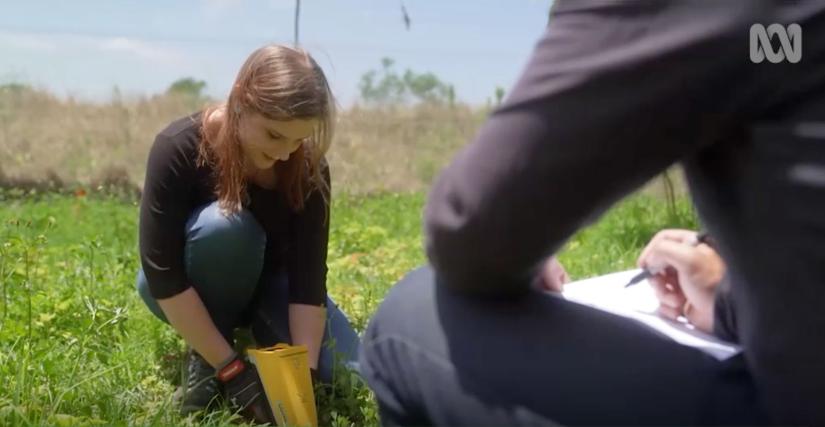Plants can deliver health benefits by remediating contaminated soil

Costa learns about the power of plants to remediate soil contaminated by industry and factories.
Costa is visiting Newcastle, 2 hours north of Sydney, a city that has a rich industrial history. On a former steelworks site, a garden has been quietly growing solutions to fix the contaminated soil left behind when industrial sites close down.
The Delprat Garden has been growing for over three years and is a collaboration between the University of Newcastle, UTS Phytolab and Landcom. There is a pumping vegie patch, a wildflower meadow, and groves of ornamental trees. The team here are researching and trialling many common plant species we would find in our home gardens for their phytoremediation capabilities. Phytoremediation is the process of using plants to remove heavy metals and pollutants from soils.
Overseeing the pioneering project is Landscape Architect & Professor SueAnne Ware. “Generally, in Australia how we deal with toxic sites is we scrape them and move the soil and make it someone else's problem. Or we put a cap over the top – that’s not a long-term solution. Phytoremediation, by taking out the contaminants, basically takes them out permanently.”
Landscape Architect Chris Johnstone is managing the trials. “This site really suffered from wind-blown contamination from the steelworks. Anecdotally, apparently it was under a cloud for 30 or 40 years.” When they first tested the soil, it was full of chromium, lead, zinc and more!
“The plants are grown straight into the existing soil, we’re not adding any fertilisers, and we’re not using any pesticides or herbicides” in order to get a clear understanding of how plants respond to the soil contaminants. Project findings are all shared online as “we really want to engage as many people as we can… it’s such a viable, low-tech, low-cost technique for remediating sites.”
Environmental Scientist Dr Megan Murray has been conducting much of the tests on the plants, with exciting results. “Sunflowers are a wonder plant at absorbing heavy metals.” They draw up lots of lead, manganese and zinc but keep it locked in the root zone, meaning the above ground parts like pollen that bees harvest or seeds that we eat, are safe to eat. Being fast growers “you can actually see quite a big change in your soil pollution levels, plus you have the confidence of knowing that you’re not going to be increasing any risks for biodiversity that’s engaging with your garden.”
When it comes to some vegetable species like mustards and tomatoes, they may be able to take the bad stuff out of the soil without storing it in plant parts you want to eat. However, this is not the case for all species, such as beans which may be harmful to eat when grown on contaminated soil. And at the extreme end, watermelons, pumpkins and carrots have been shown to absorb huge amounts of pollutants effectively. This makes them inedible, however they could help clean up soils quickly and at a low cost.
Next steps for research
Lots of Australian natives are also in the trial, from eucalypts to grasses and climbers. There is little data yet to understand their phytoremediation abilities and tolerance of heavy metals, however, so far kangaroo grass is a least thriving on the site!
Another area of study is what to do with waste plant materials generated by the site. Currently, they are contained away from the soil in compost bins to reduce the mass of waste, but there is still some contaminated waste left behind. The team say this is an exciting next area of research and hopes more scientists along with local and state governments can get on board with finding a solution.
Advice for home gardeners
- Get your soil tested. If you know your garden contains building rubble, was a former industrial site, or there’s a chance of lead paint runoff from the house, chances are heavy metals and other pollutants are present.
- Use raised garden beds for edible plants
- And keep an eye on the data available from this project so you can be confident in choosing edible plants that are safer for contaminated sites, and choosing ornamental plants that can tolerate and even remediate contaminated sites
While this project is still in the early stages, there is a lot of promising data already that could lead to big changes in how we deal with polluted land. And at the centre of this ground-breaking research is of course resilient, amazing plants providing practical solutions!
Featured Plants |
|
|---|---|
|
MORETON BAY FIG |
Ficus macrophylla |
|
SWEET ALYSSUM |
Lobularia maritima |
|
BORAGE |
Borago officinalis * |
|
SUNFLOWER |
Helianthus cv. |
|
KANGAROO GRASS |
Themeda triandra |
|
CREPE MYRTLE |
Lagerstroemia cv. |
|
MUSTARD |
Brassica juncea cv. |
|
BEAN |
Phaseolus vulgaris cv. |
|
TOMATO |
Solanum lycopersicum cv. |
* Check before planting: this may be an environmental weed in your area
Filmed on Awabakal Country | Newcastle, NSW
Watch the full program on abc.net.au: Plants to the Rescue

